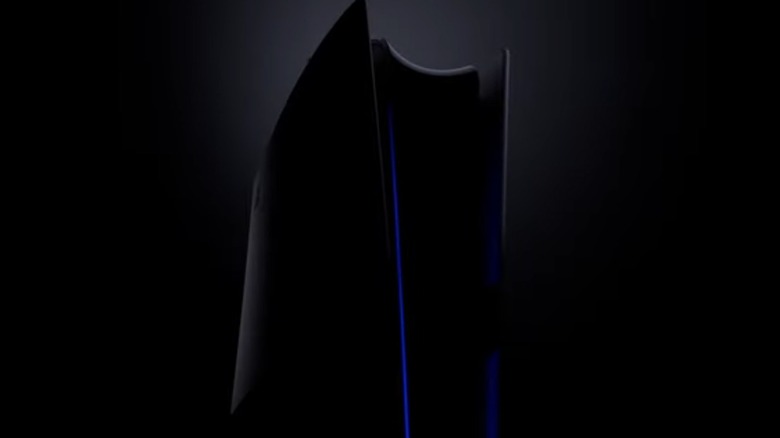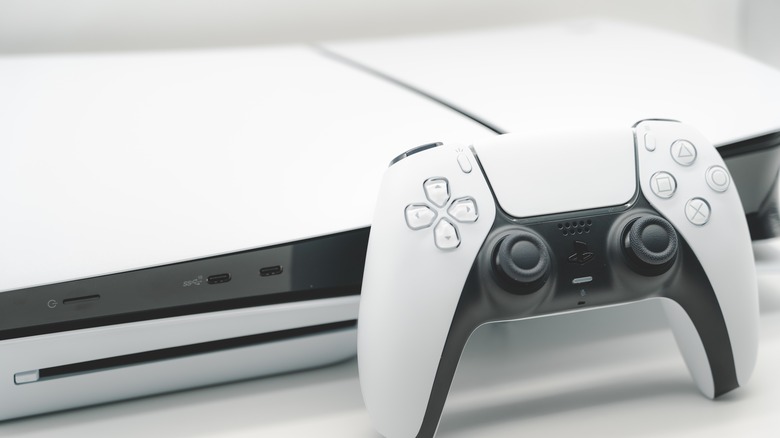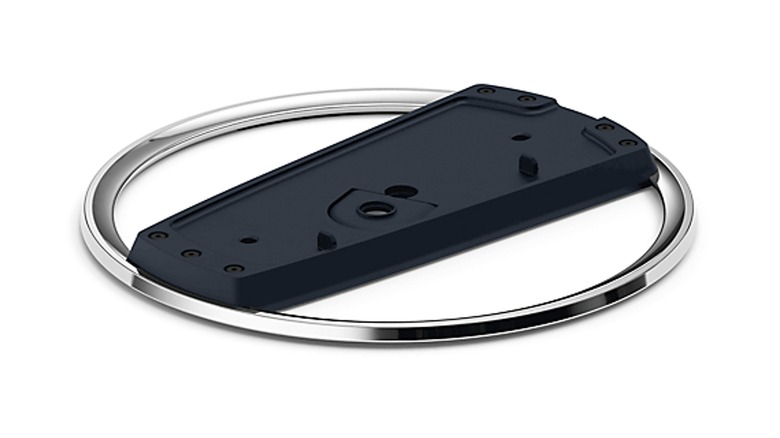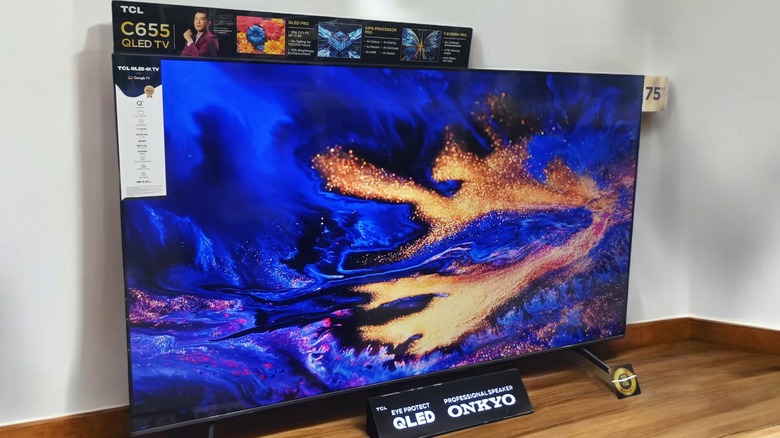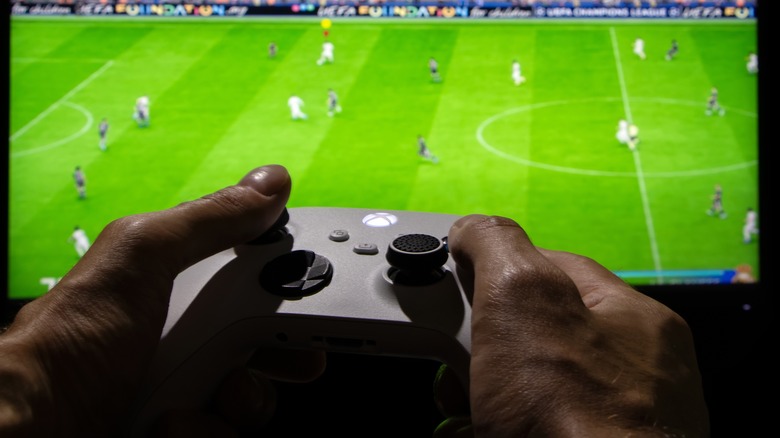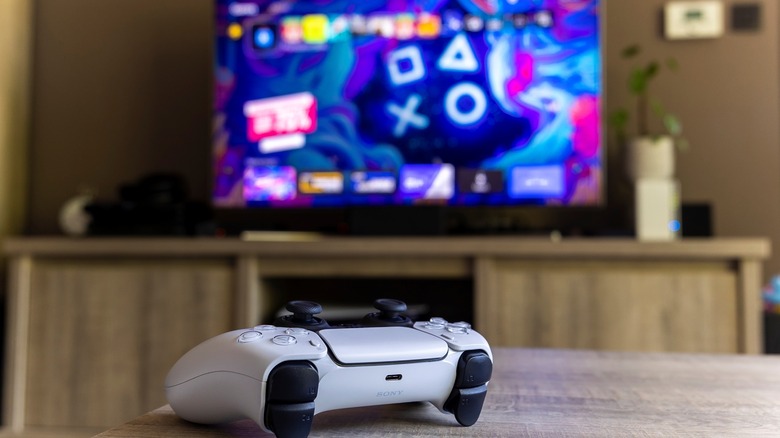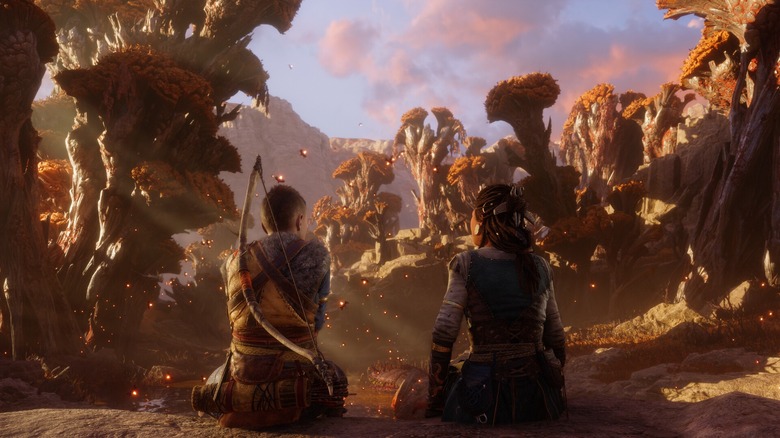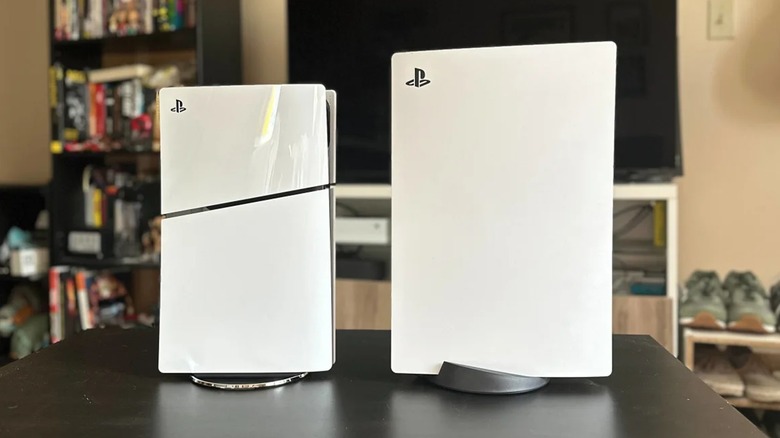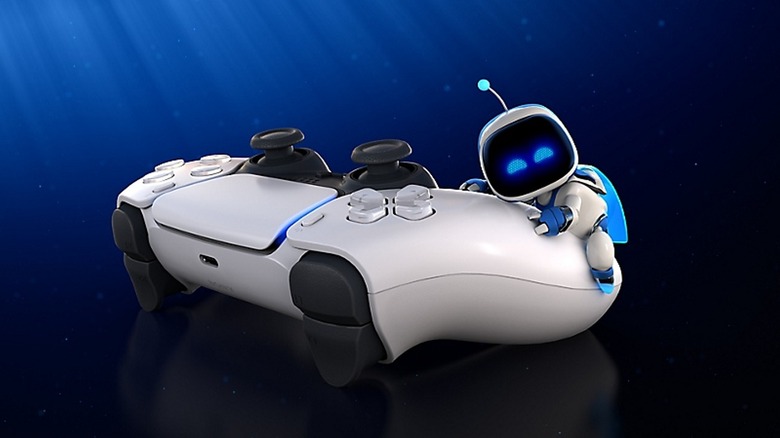10 Features We Want To See In PlayStation 5 Pro
Gamers have wanted a PlayStation 5 Pro ever since, well, Sony announced the PlayStation 5. After all, Sony updated the original PlayStation 4 with the PlayStation 4 Pro, so it's always felt inevitable the company would release a beefier PS5. But what can we expect?
Recently, leaks regarding the PlayStation 5 Pro have swept across the internet, reinvigorating interest in Sony's mid-generation update. Previously, we'd only heard rumors, but the latest batch of unofficial info sounds both promising and believable. Assuming the claims are true, we should expect a console that is more powerful than the base PS5 (as if there ever were any doubt), to the point it can render ray-traced graphics without much slowdown. But is that it? Graphical fidelity isn't the selling point it used to be, and a new console will need more to survive in the current video game climate, even if it's a follow-up to the excellent PlayStation 5. Moreover, Sony made some questionable decisions with the PS5 and its demi-update, the PlayStation 5 Slim, and fans need reassurances the manufacturer has learned from its mistakes in the lead-up this new console's confirmed release date of November 7, 2024.
Here are 10 features we would like to see in the PlayStation 5 Pro.
Disk drives
Until the most recent console generations, all games came on disks and cartridges. Microsoft started manufacturing the first big-name all-digital console, and Sony followed suit with the PlayStation 5, partially. It would be a bad idea if Sony went all in on an all-digital future, especially if the PlayStation 5 Pro is its start.
To be blunt, disk drives are an important part of a console, prospective PS5 Pro included. Many people who purchase one will likely either already own PlayStation 5 and PlayStation 4 games, including physical copies. Moreover, when owners inevitably purchase new titles, as tempting as it is to buy them digitally, It's generally cheaper to purchase physical copies because numerous stores hold sales. Some stores are even devoted to selling used copies, generally at deep discounts. As an added bonus, if a digital game is delisted from the PlayStation store or unavailable in certain countries, anyone can own the title so long as they buy the disk.
When Sony revealed the PlayStation 5 Slim, the company introduced two models, much like when the original PlayStation 5 launched. However, it also released an optional external disk drive, in case you come to regret buying the digital edition. Best case scenario, the PlayStation 5 Pro follows in the Slim's footsteps and can either come with a disk drive preinstalled or accept one later. Manufacturing a PS5 Pro with absolutely no disk support would just be asking for controversy.
A better stand
Game consoles have come in a variety of shapes and sizes, but most have been generally boxy. That semi-universal design often lets owners orient consoles more than one way. The PlayStation 5 was an exception to the rule, which helped it stand out, albeit at a cost.
To keep the PlayStation 5 balanced, owners need a stand. This "add-on" can attach to the bottom for vertical orientation and slip onto one side for horizontal use. However, the design is far from foolproof, as owners have to twist stand parts and install screws depending how they want to orient their console. This is a far cry from the Xbox Series X/S design, which only asks users to turn the console 90 degrees. And Sony redesigned the stand for the PlayStation 5 Slim in the worst way possible — it wasn't needed for laying the console horizontally anymore (the console came with little detachable feet), but it was required if users wanted to set the PS5 Slim vertically, and it cost extra.
Given the negative reaction Sony faced after not shipping the PS5 Slim with a stand, the company needs to include bases with the PlayStation 5 Pro. Many gamers don't like having to shell out extra money for more console setup options. Almost as importantly, this new hypothetical stand should ideally be easier to use than the original. No need to reinvent the wheel, just let PS5 Pro owners swap between horizontal and vertical console orientations with fewer steps.
Better resolutions and higher framerates
When Sony initially announced the PlayStation 5 — and when Microsoft announced the Xbox Series X/S — a lot of focus was spent on graphical capabilities. While the actual console didn't quite live up to promises, its upgrade can.
In initial marketing campaigns, Sony promised features such as 4K resolutions and 120 FPS framerates. No other console could do this, except for the then-upcoming Xbox Series X, that is. However, Sony failed to mention that these settings would be mutually exclusive. Like the PlayStation 4 Pro before it, games on the PS5 offer two graphics settings: Performance and Presentation. The former offers a solid 60-120 FPS but with 1080p resolutions and no high-end post-processing techniques such as ray-tracing, whereas the latter cranks the resolution up to 4K and maximizes graphical settings while reducing framerates to 30 FPS at most.
If the PlayStation 5 Pro's hardware is as powerful as the leaks claim, then Sony can and should finally deliver the performance promised in those initial PS5 trailers. While games will still probably utilize Performance and Presentation settings, the PS5 Pro could up the ante. Performance mode could be redefined to 60FPS if not 120FPS at 4K with ray-tracing, while Presentation could deliver 60 FPS at 8K and other settings that might eclipse most gaming PCs. Then again, if the PS5 Pro keeps the multiple settings, Sony might save some of the PS5 Pro's new rendering and post-processing technologies (more on those later) for some graphical presets.
Dolby Vision support
For the most part, the PlayStation 5 and the Xbox Series X are similar devices. They play many of the same games and offer the same screen resolutions, but they aren't exactly the same. After all, you can't play "Final Fantasy XVI" on the Xbox, and there are also things the Xbox Series X can do that the PlayStation 5 can't, one of which makes games look even better on specific TV sets.
One of the Xbox Series X's exclusive features is support for Dolby Vision, a proprietary program that improves picture quality dynamically. Dolby Vision examines the service, TV, and device being used and tabulates the best image quality possible. Compared to a standard like HDR10, Dolby Vision provides superior color accuracy and contrast. And while not every TV can utilize Dolby Vision, those that do deliver richer pictures for Xbox Series X games.
While the PS5 has 4K and HDR capabilities, Dolby Vision is widely regarded as superior to HDR, so while PS5 games look amazing (quite frankly many look better than Xbox Series X games), they are still hampered by the whims of TV picture settings. Adding Dolby Vision support would potentially push these games further than they ever could have gone without that technology. What good is a powerful console if you don't have a TV that lets you appreciate every individual rendered pixel?
Quick Resume
As previously stated, the Xbox Series X can do some things the PlayStation 5 can't and the reverse is also true. One Xbox Series X/S feature channels the full power of the console's SSD; the PlayStation 5 Pro could easily mimic this capability given its presumably stronger hardware.
Arguably the most impressive feature of the Xbox Series X/S is its Quick Resume, which uses save states to let players stop one game, play another, and then switch back without loading screens. This function is only useful for gamers who play more than one title at a time, but that's still a large percentage of audiences. Xbox owners can Quick Resume three or more titles at once, depending on the games they play. Comparatively, the PlayStation 5 only has a "Switcher" that swaps between two games. Not quite as useful because it's far more limited.
While the PlayStation 5 Pro wouldn't be able to call it Quick Resume, as the name is presumably copyrighted, the console can take a page out of Xbox's playbook and expand its Switcher functionality to include more simultaneous game save states. After all, it's not exactly fair that Xbox owners can pause "Red Dead Redemption 2," play "Fortnite" and "Apex Legends" with friends, then go back to "RDR2" without missing a beat. The PS5 Pro's hardware should have more than enough memory to suspend multiple games at once, so why not add that functionality?
More entertainment apps
Video game consoles aren't for just video games anymore. Like all of the best smart TVs on the market, PlayStation 5 and Xbox Series X/S consoles have plenty of entertainment apps. Owners can stream music, movies, and TV shows through several services. However, as of writing, some apps are locked behind console exclusivity.
PlayStation 5 has access to some of the best streaming apps around, including Amazon Prime, Disney+, Netflix, and Spotify, but the Xbox Series X/S has all of these plus apps such as PeacockTV, Starz, FXNow, and Pandora. While owners can use the PS5's existing services to stream plenty of shows, all these apps hinge on subscriptions. If someone pays for PeacockTV and not Netflix, they can't watch their favorite shows and movies on their PlayStation 5. Buying a Netflix subscription sounds like an easy solution, but not everyone has the cash for that.
Given the mercurial nature of streaming services, it would be wise for Sony to add more options to the PlayStation 5 Pro. Apps such as PeacockTV, Starz, FXNow, and Pandora would be a great start. If, say, Hulu were to drop a show, but Peacock keeps it, fans could still be able to watch that program on their PlayStation 5 Pro. It's reassuring knowing that no matter what subscriptions you have, you'll be able to watch them on your console.
Anti-aliasing and upscaling
Graphical fidelity is the result of many technologies working together. Every 3D asset starts with the base models and all their polygons — the more polygons, the more detailed the model. Then comes textures, particle effects, and lighting, but these are only the start. For the best graphics, one needs hardware that can support intense post-processing.
Anti-aliasing and upscaling are two important graphical settings that seriously impact the way games look. Anti-aliasing smooths out jagged edges in images, and upscaling blows up images to fit large, high-resolution screens while also improving image clarity and presentation. Some game engines include their own anti-aliasing technologies, but it's better to rely on a GPU's built-in anti-aliasing (aka NVIDIA DLSS, or the like). Case in point, PlayStation 5 Pro leaks first teased the upcoming console will have proprietary upscaling and anti-aliasing tech dubbed PlayStation Spectral Super Resolution Upscaling (PSSR), the Sony's recent technical presentation confirmed it. According to that technical presentation, PSSR should be a considerable improvement over the PS5's current anti-aliasing technique, Super Sampling Anti-aliasing (SSAA), helping with ray tracing in particularly.
While we hope most if not all of the PS5 Pro leaks are legit, we hope the anti-aliasing and upscaling capabilities of PSSR are the most legit of all. SSAA is an effective anti-aliasing tool, but it isn't exactly efficient. It over-samples the entire screen and uses more energy than it should — essentially it's a sledgehammer solution when a scalpel would suffice. The PS5 Pro could provide just that, if the leaks are to be believed.
Smaller size
Technology has an odd relationship with size. As time goes on, we learn how to cram more power into progressively smaller spaces, yet new generations of phones, graphics cards, and game consoles are often progressively larger than the last. Look no further than the PlayStation 5.
At 15.4 inches x 10.2 inches x 4.1 inches, the PlayStation 5 takes up 644 cubic inches, making it the biggest video game console ever — the Xbox Series X is comparatively only 414 cubic inches. Much of this volume is due to the PS5's unique shape and top fins. While the PlayStation 5 Slim doesn't modify this shape, it significantly cuts down the volume. The console isn't as compact as the Series S and its 169 cubic inches, but the PlayStation 5 Slim is almost as small as the Series X at 440 cubic inches. That more than 30% drop allows the PS5 Slim to squeeze into areas the vanilla PS5 can't.
Odds are the PlayStation 5 Pro will be larger than the original PS5, but there's a non-zero chance that it will be smaller, or at the very least a less significant size increase than the PlayStation 4 to PlayStation 4 Pro. According to leaks, the PS5 Pro will utilize the same CPU and have more efficient RAM, which could save on space. While hoping the PS5 Pro isn't a monolith of game rendering power is a bit of a pipe dream, the GPU could serve as a deciding factor.
More than 1 TB storage
In order to fit more programs on computers and game consoles, manufacturers started using larger hard drives. With more available space, game studios started developing bigger games. Thus began a vicious cycle that has once again swung around to the hard drive side of things.
Every base PlayStation 5 utilizes a 1 TB SSD, but that's not the same as saying the consoles provide 1 TB worth of storage space. The PS5 actually has 825 GB, whereas the PlayStation 5 Slim has a slightly bigger drive with a genuine 1 TB worth of storage. That sounds like a good amount until you see the file sizes of PS5 games these days. "Final Fantasy VII Rebirth," for instance, requires 145 GB, whereas "Call of Duty: Modern Warfare 3" demands 235 GB. If installed together, those two games eat up almost half of a standard PlayStation 5 SSD.
Given the exponentially expanding nature of game file sizes, the PlayStation 5 Pro needs more internal storage, so owners can keep as many games on the SSD as possible. Granted, people can just extend their game storage with an external hard drive or an extra SSD, but those solutions can cost hundreds of dollars. Plus, PS5 games don't work on external drives and owners have to install SSDs into an internal drive slot. Even if Sony doesn't upgrade the base SSD size for the PS5 Pro, the company could at least enlarge the secondary SSD slot to allow for a wider variety of drives.
Astro's Playroom
Back in the old days, console manufacturers provided a free game with every product. How else do you think "Tetris" and "Sonic the Hedgehog" become some of the best-selling games on the Game Boy and Sega Genesis, respectively? Today, consoles don't include pack-in games with one exception: the PlayStation 5 — technically two, thanks to the PlayStation 5 Slim. Ideally, the Playstation 5 Pro will make three.
Every PS5 and PS5 Slim include a copy of "Astro's Playroom," a single-player title that stars a cute little robot named Astro. The game is a short adventure through platforming levels that run players through the PS5's main features, most of which pertain to the DualSense controller's haptic feedback. Even if a new PS5 owner doesn't enjoy platformers, "Astro's Playroom" is a must-play thanks to its charm and ability to organically teach players about PS5 features.
We don't want "Astro's Playroom" to be included in the PS5 Pro, we need it to be included in the PS5 Pro. The console might very well be many gamers' first experience with a current-gen gaming console since half of all PlayStation gamers still use a PlayStation 4 (according to Game File's Stephen Totilo). Ergo, Sony should treat the PS5 Pro as such. Not only should Sony ease players into the console's capabilities with "Astro's Playroom," the company should utilize an updated version that takes advantage of the Pro's beefier graphical components. Plus, Sony recently launched a sequel to the game, "Astro Bot." What better marketing could it ask for?
